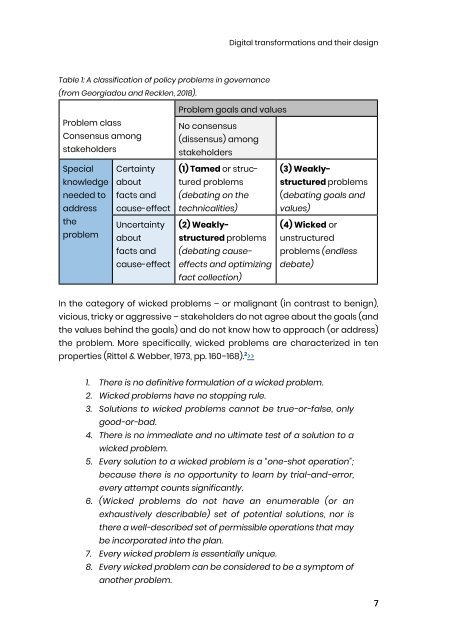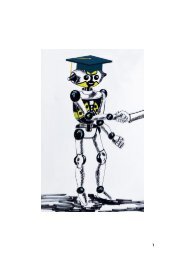13. Digital transformations and their design – renewal of the socio-technical approach
Create successful ePaper yourself
Turn your PDF publications into a flip-book with our unique Google optimized e-Paper software.
<strong>Digital</strong> <strong>transformations</strong> <strong>and</strong> <strong><strong>the</strong>ir</strong> <strong>design</strong><br />
Table 1: A classification <strong>of</strong> policy problems in governance<br />
(from Georgiadou <strong>and</strong> Recklen, 2018).<br />
Problem class<br />
Consensus among<br />
stakeholders<br />
Problem goals <strong>and</strong> values<br />
No consensus<br />
(dissensus) among<br />
stakeholders<br />
Special<br />
knowledge<br />
needed to<br />
address<br />
<strong>the</strong><br />
problem<br />
Certainty<br />
about<br />
facts <strong>and</strong><br />
cause-effect<br />
Uncertainty<br />
about<br />
facts <strong>and</strong><br />
cause-effect<br />
(1) Tamed or structured<br />
problems<br />
(debating on <strong>the</strong><br />
<strong>technical</strong>ities)<br />
(2) Weaklystructured<br />
problems<br />
(debating causeeffects<br />
<strong>and</strong> optimizing<br />
fact collection)<br />
(3) Weaklystructured<br />
problems<br />
(debating goals <strong>and</strong><br />
values)<br />
(4) Wicked or<br />
unstructured<br />
problems (endless<br />
debate)<br />
In <strong>the</strong> category <strong>of</strong> wicked problems <strong>–</strong> or malignant (in contrast to benign),<br />
vicious, tricky or aggressive <strong>–</strong> stakeholders do not agree about <strong>the</strong> goals (<strong>and</strong><br />
<strong>the</strong> values behind <strong>the</strong> goals) <strong>and</strong> do not know how to <strong>approach</strong> (or address)<br />
<strong>the</strong> problem. More specifically, wicked problems are characterized in ten<br />
properties (Rittel & Webber, 1973, pp. 160<strong>–</strong>168). 2 >><br />
1. There is no definitive formulation <strong>of</strong> a wicked problem.<br />
2. Wicked problems have no stopping rule.<br />
3. Solutions to wicked problems cannot be true-or-false, only<br />
good-or-bad.<br />
4. There is no immediate <strong>and</strong> no ultimate test <strong>of</strong> a solution to a<br />
wicked problem.<br />
5. Every solution to a wicked problem is a “one-shot operation”;<br />
because <strong>the</strong>re is no opportunity to learn by trial-<strong>and</strong>-error,<br />
every attempt counts significantly.<br />
6. (Wicked problems do not have an enumerable (or an<br />
exhaustively describable) set <strong>of</strong> potential solutions, nor is<br />
<strong>the</strong>re a well-described set <strong>of</strong> permissible operations that may<br />
be incorporated into <strong>the</strong> plan.<br />
7. Every wicked problem is essentially unique.<br />
8. Every wicked problem can be considered to be a symptom <strong>of</strong><br />
ano<strong>the</strong>r problem.<br />
7


















